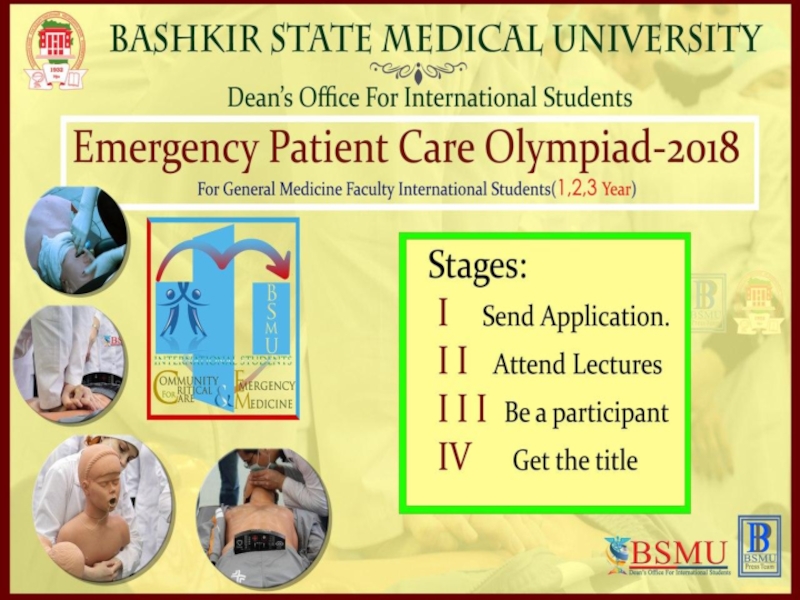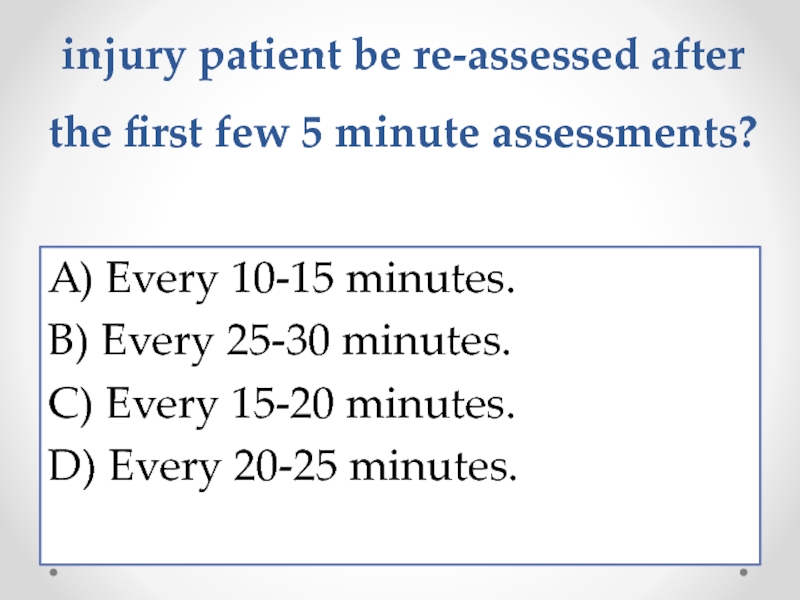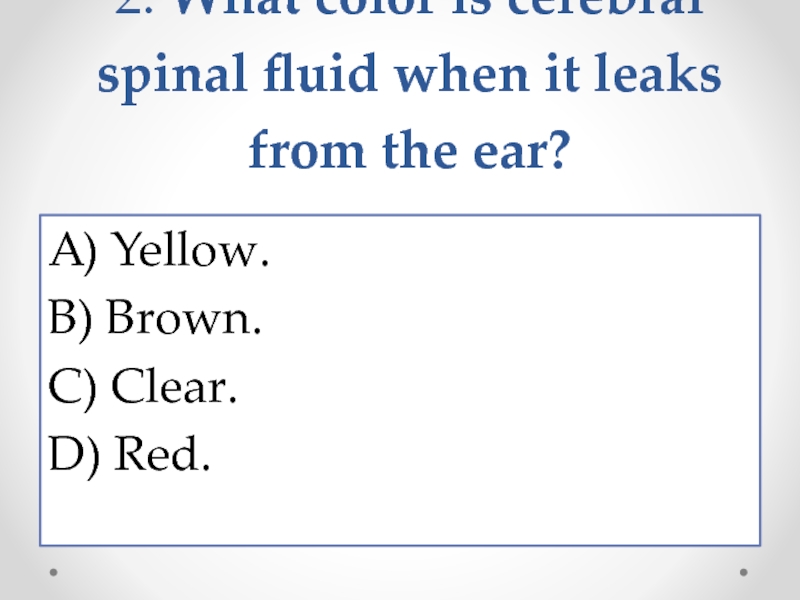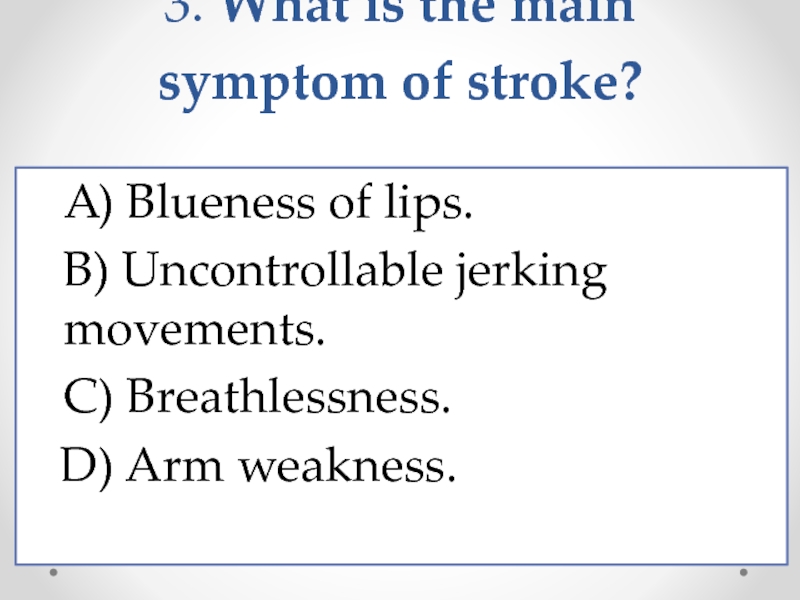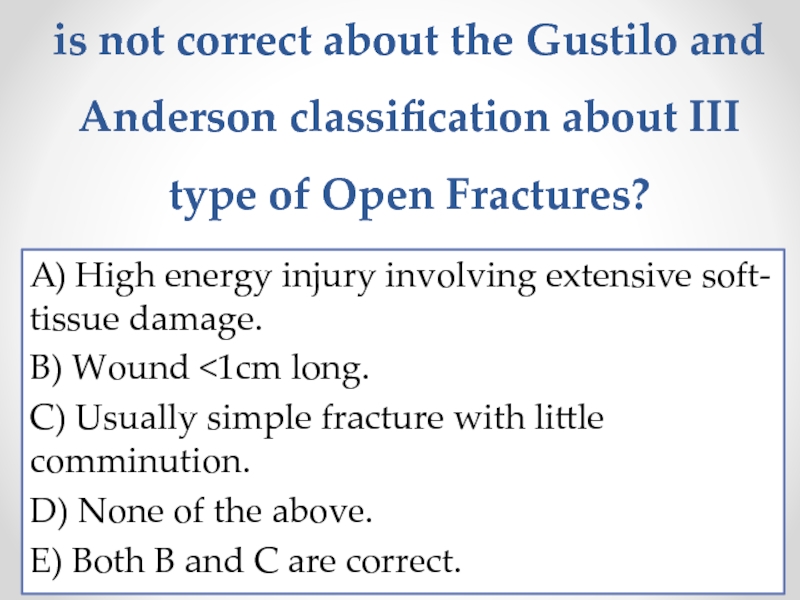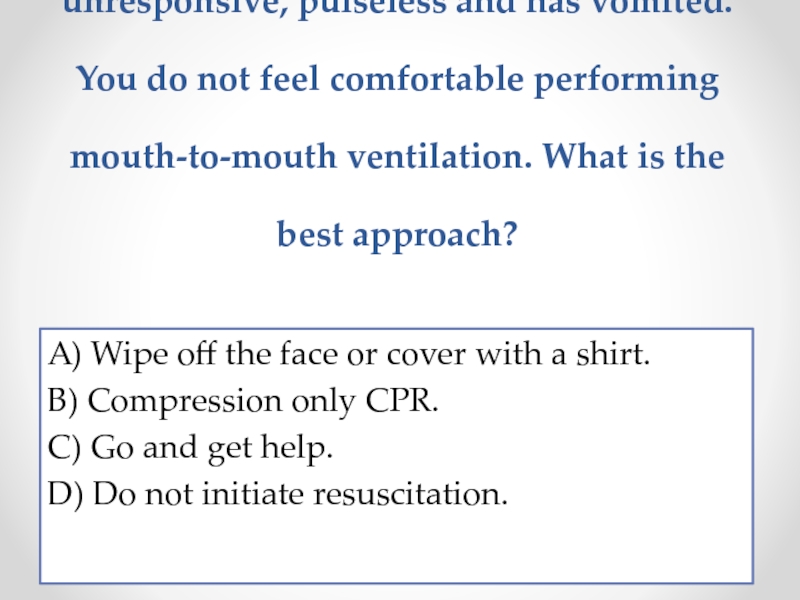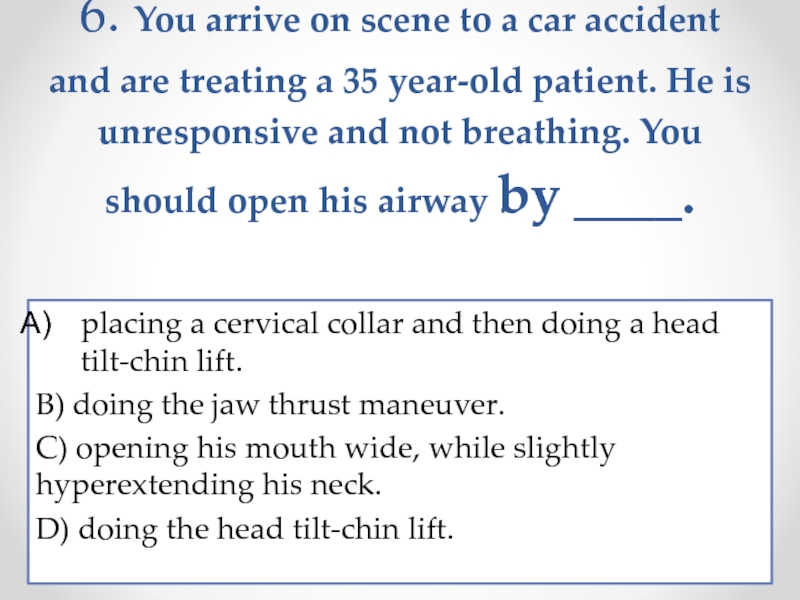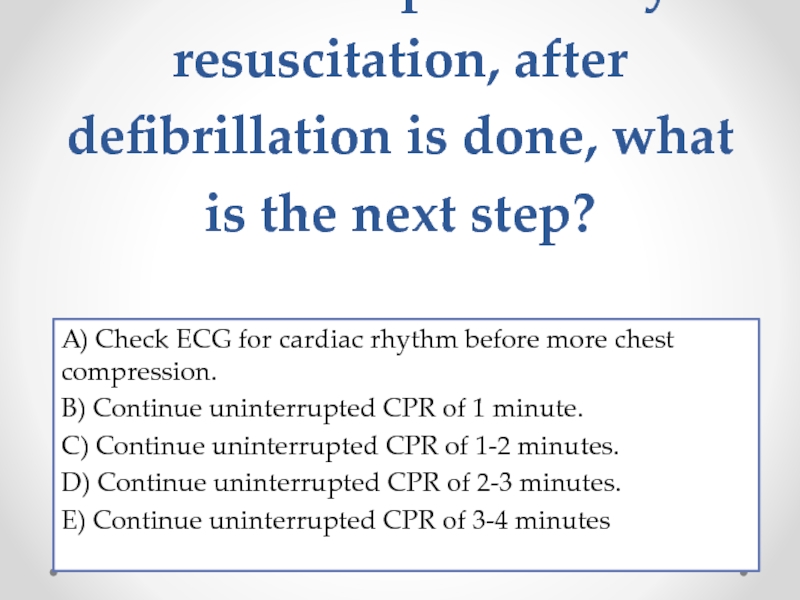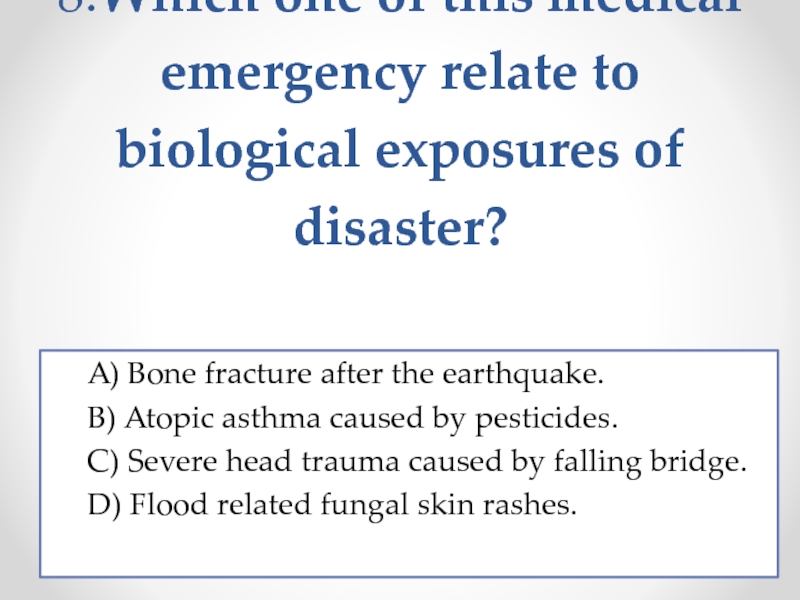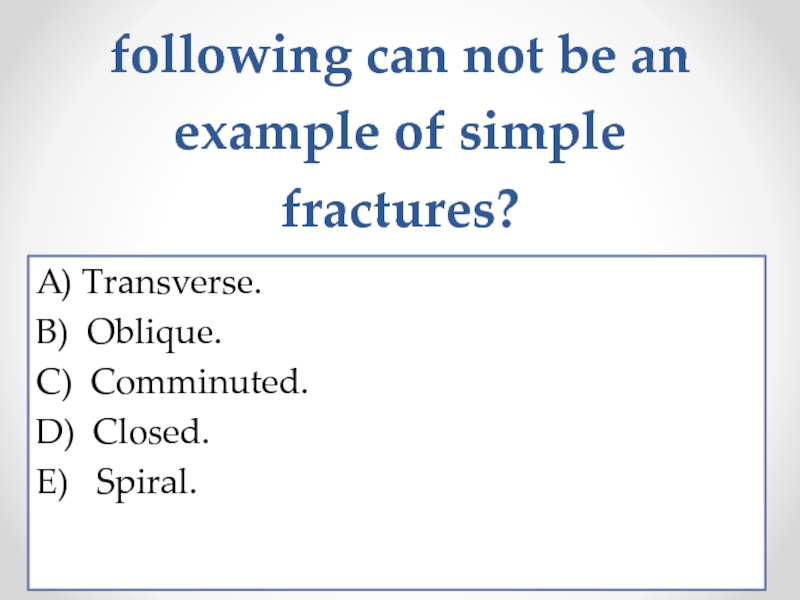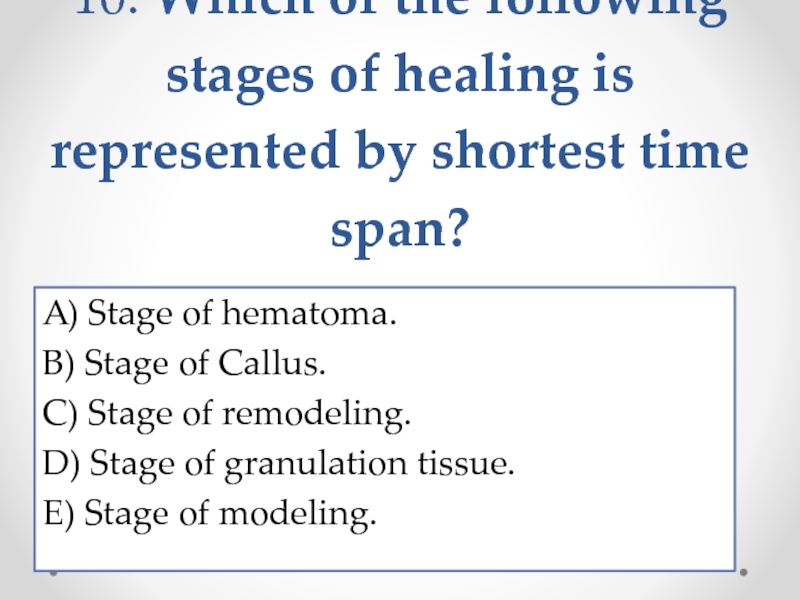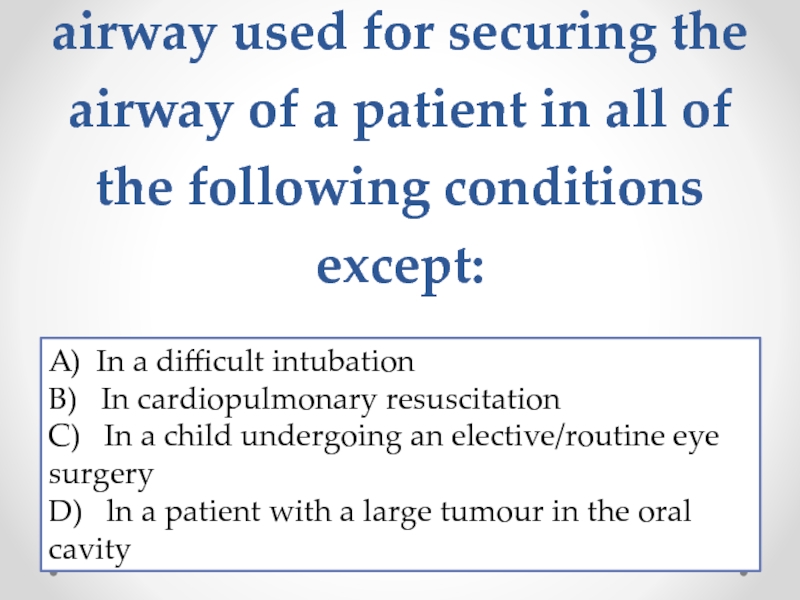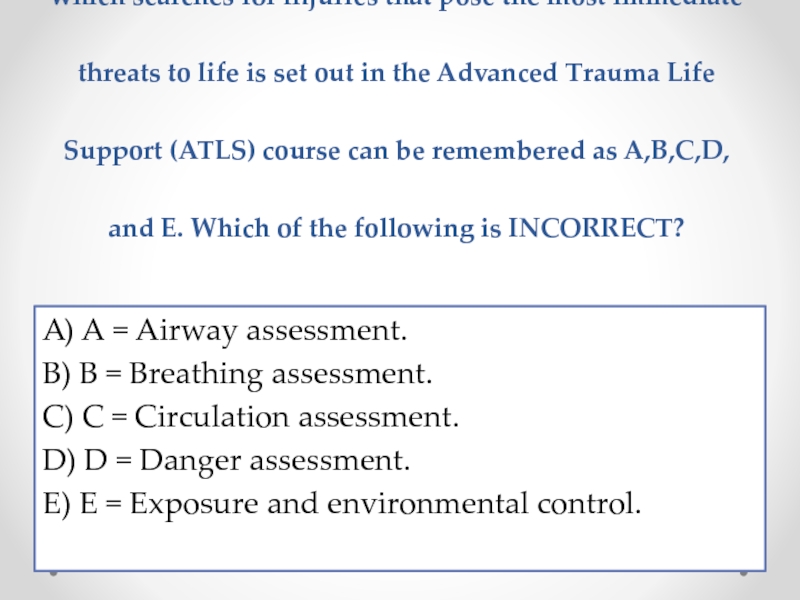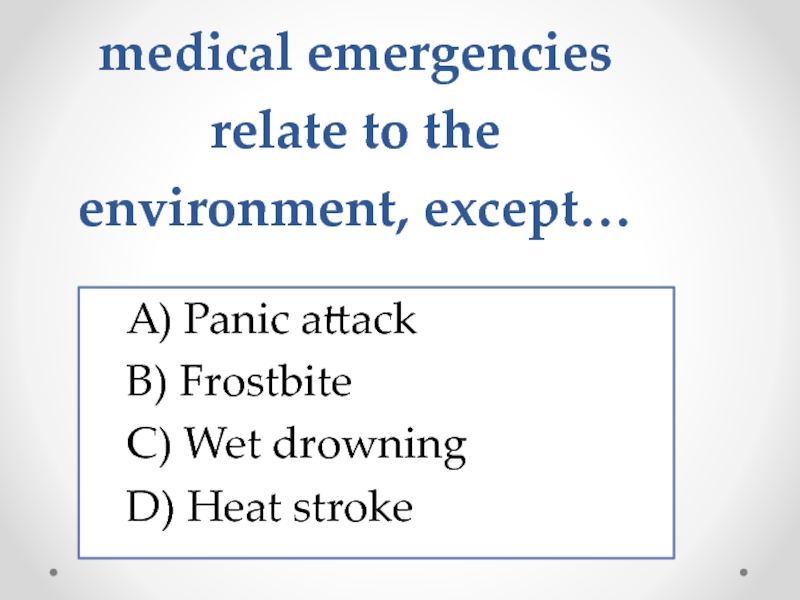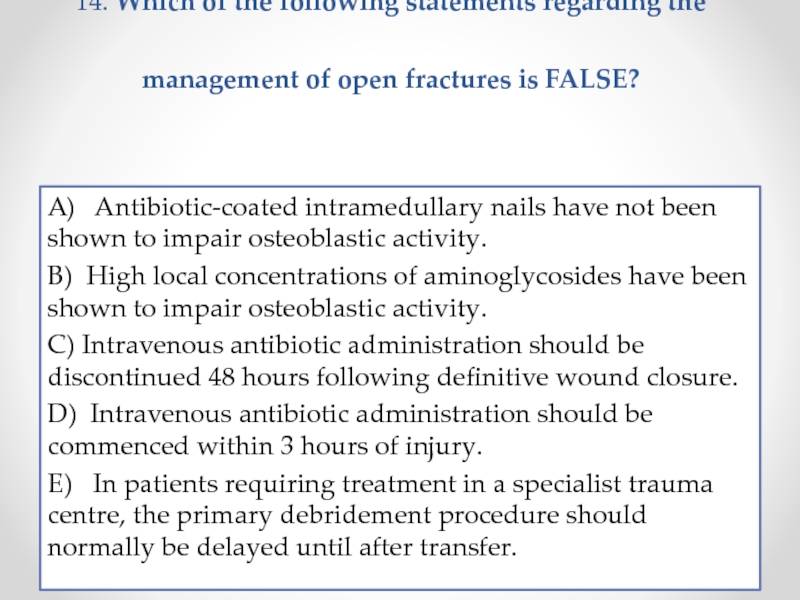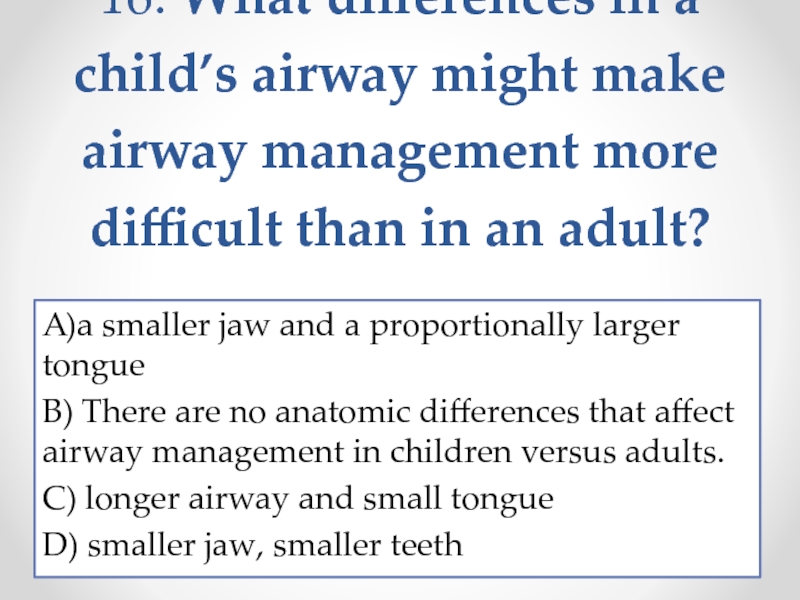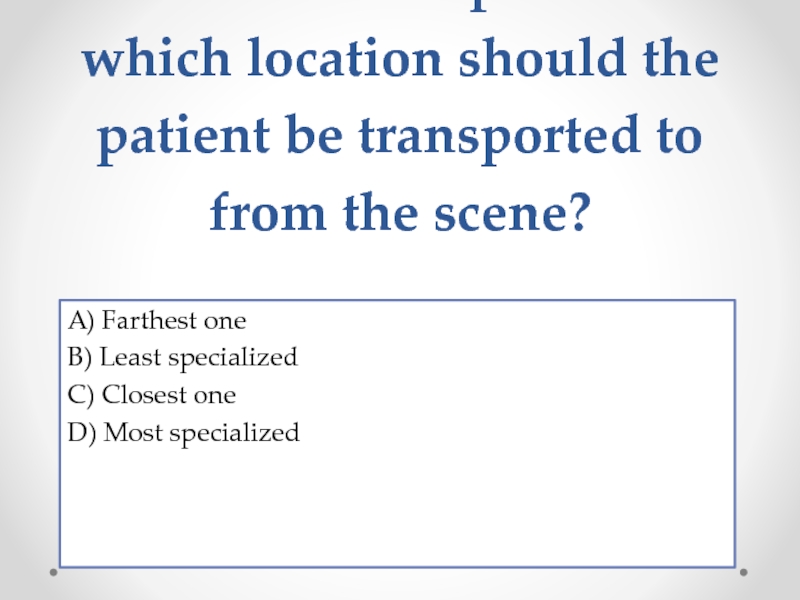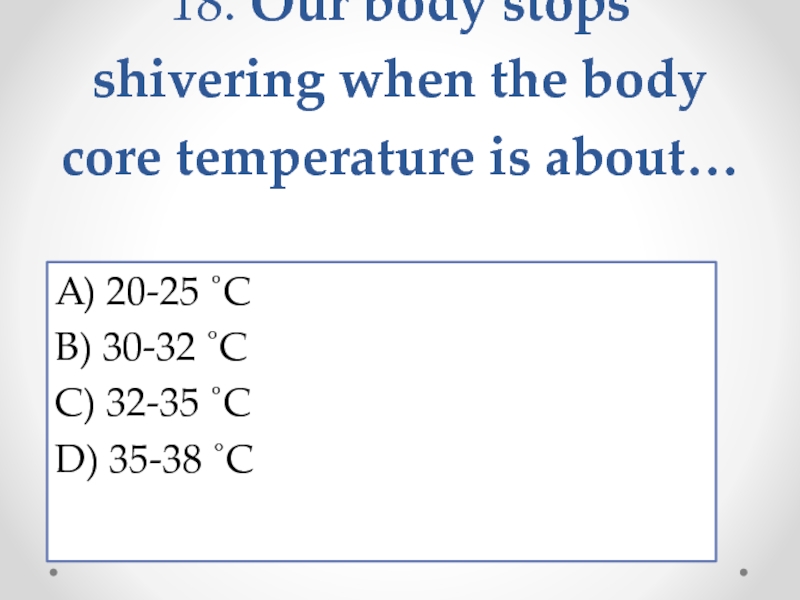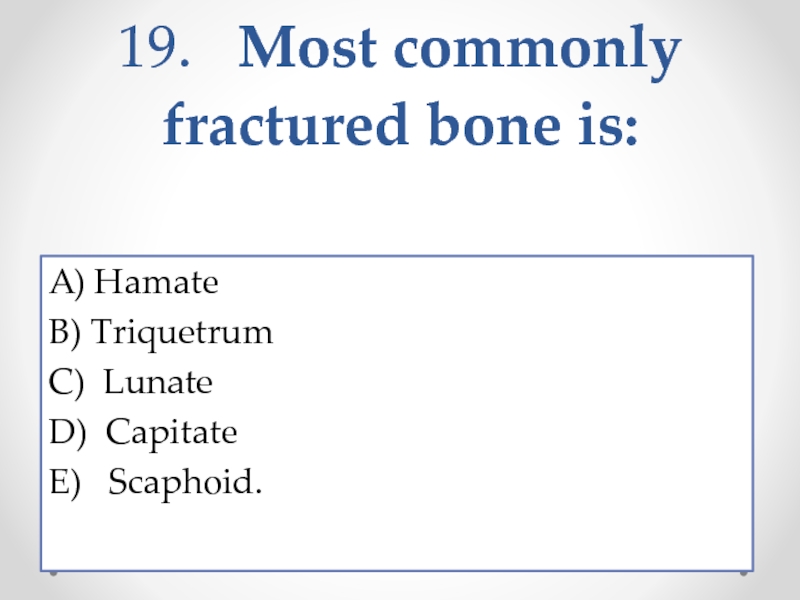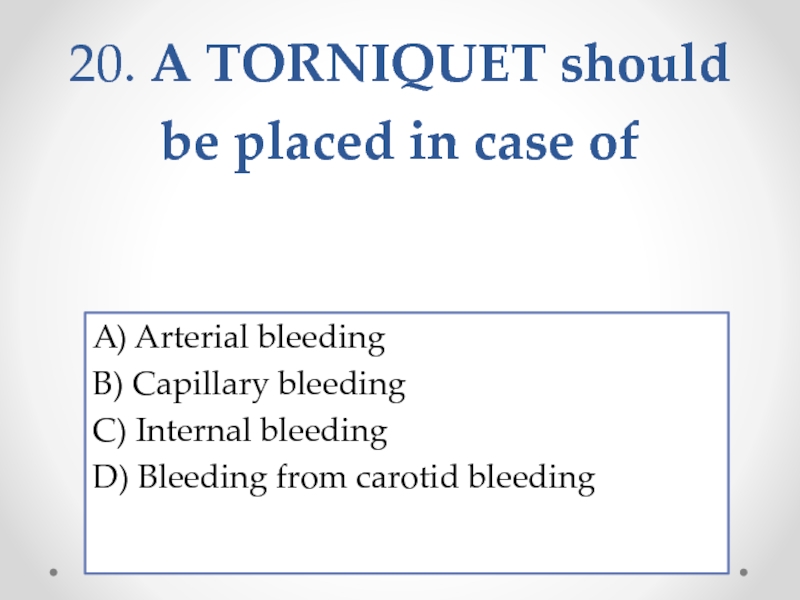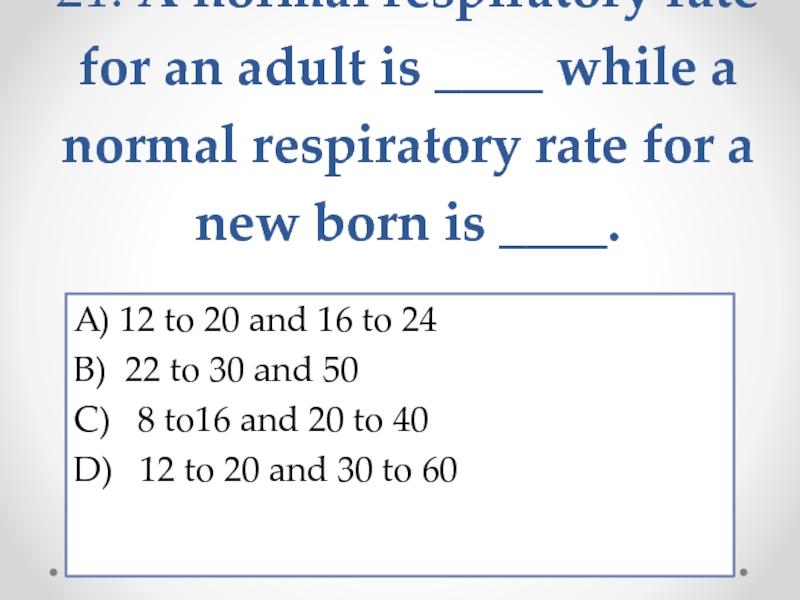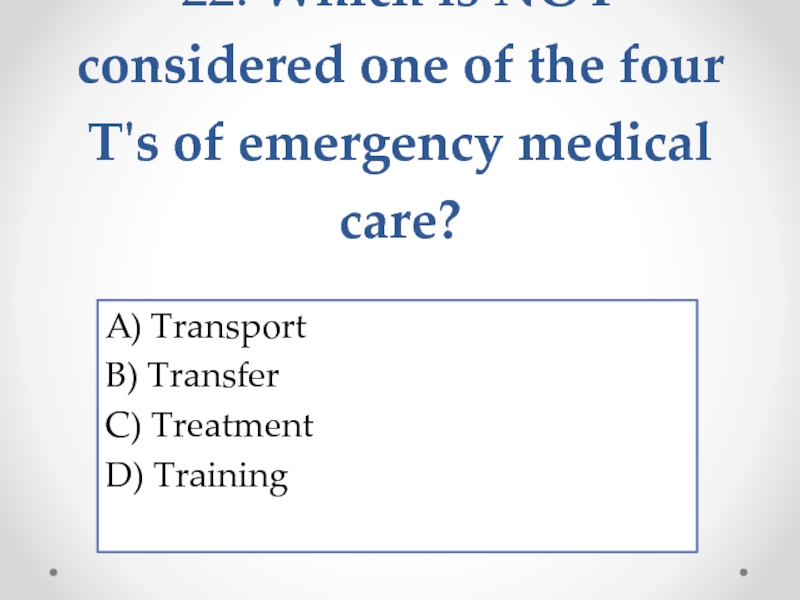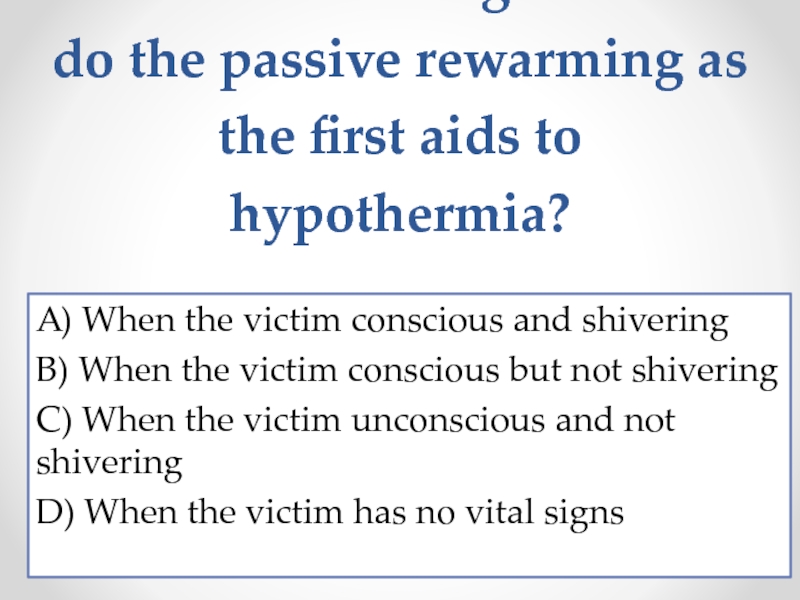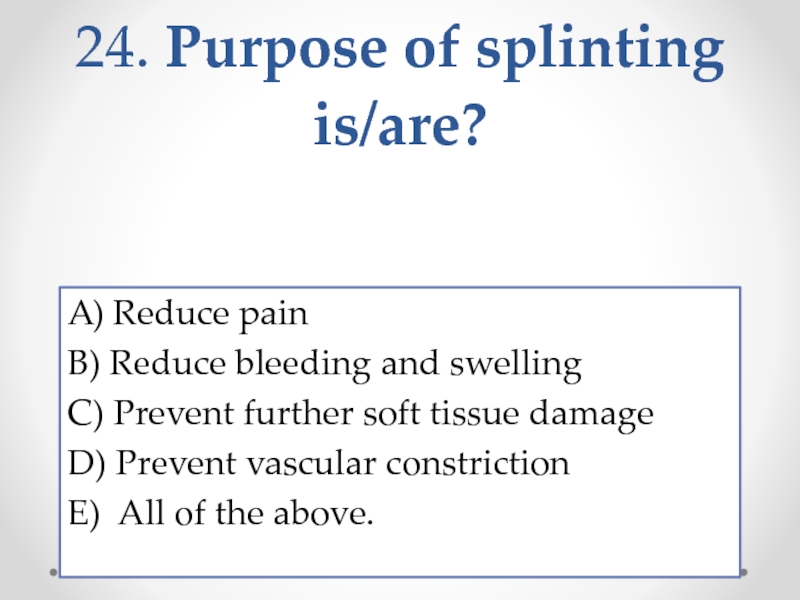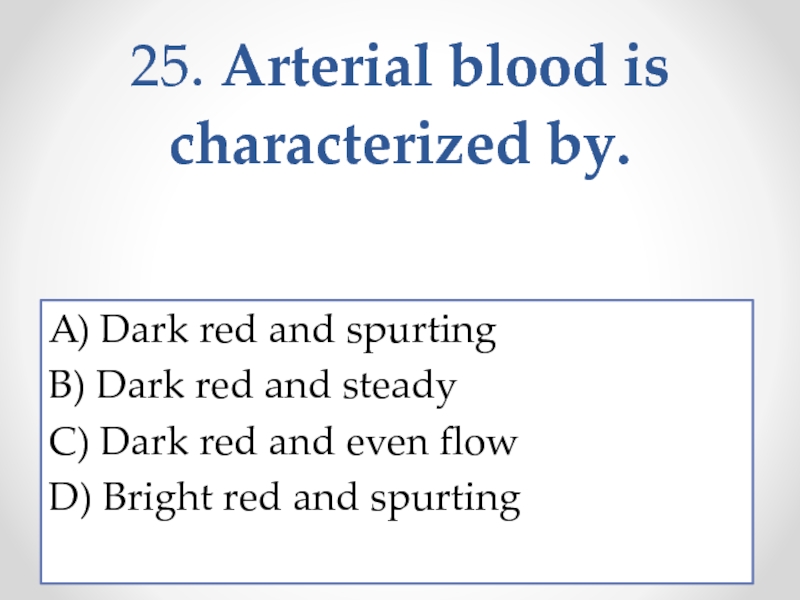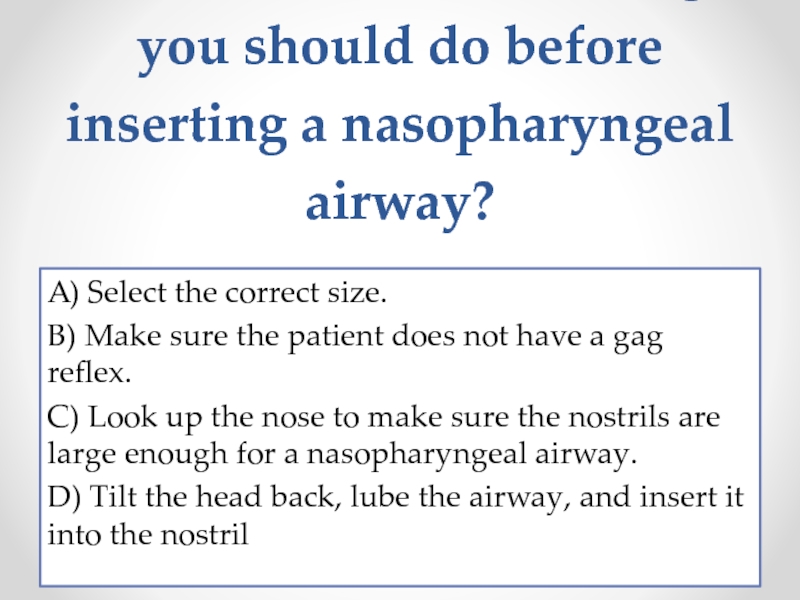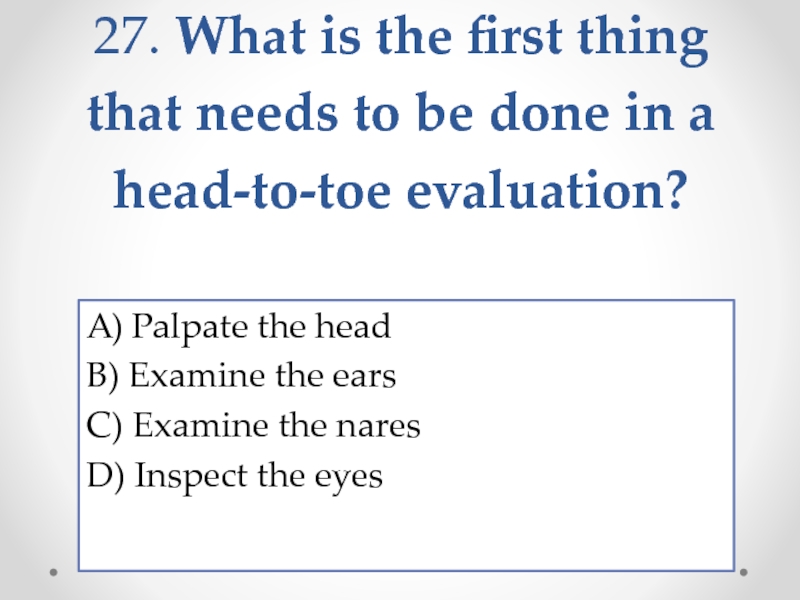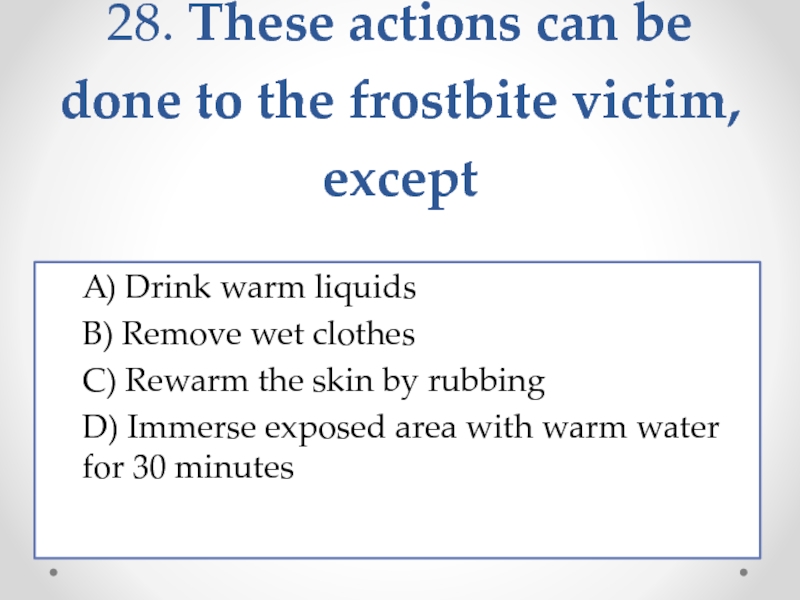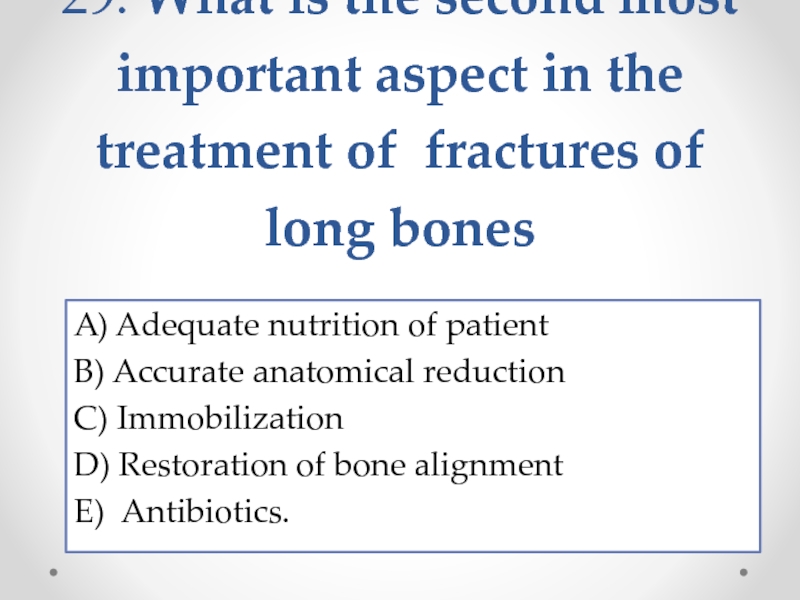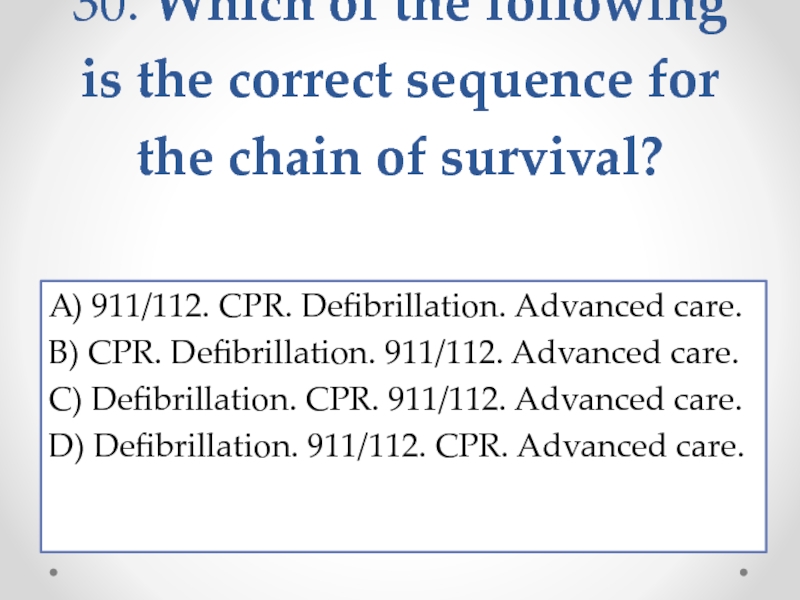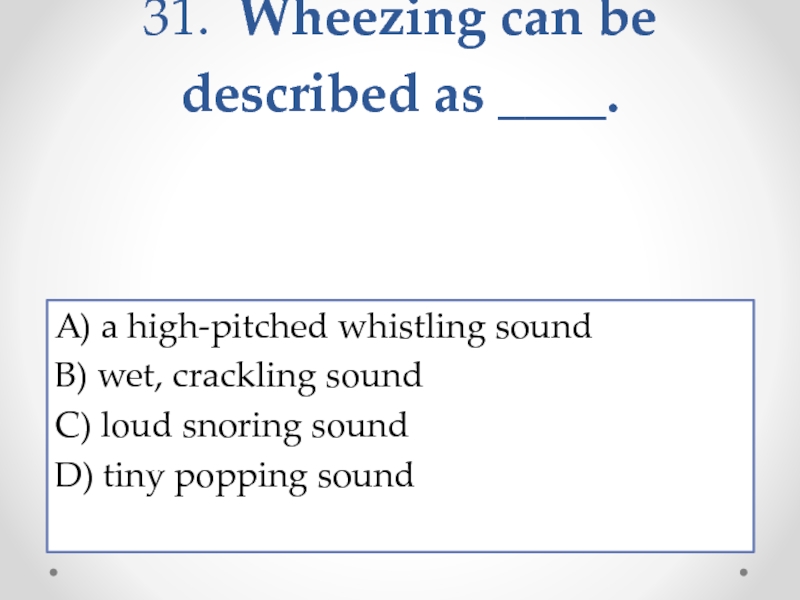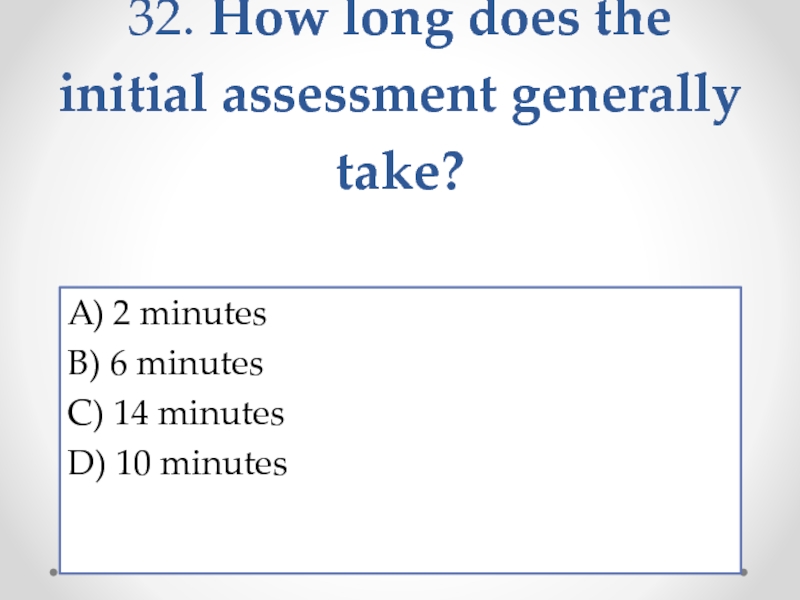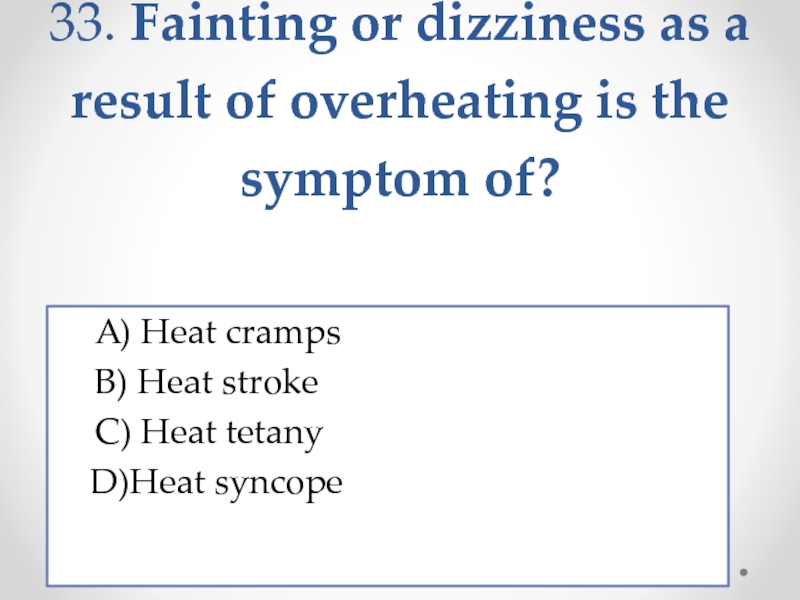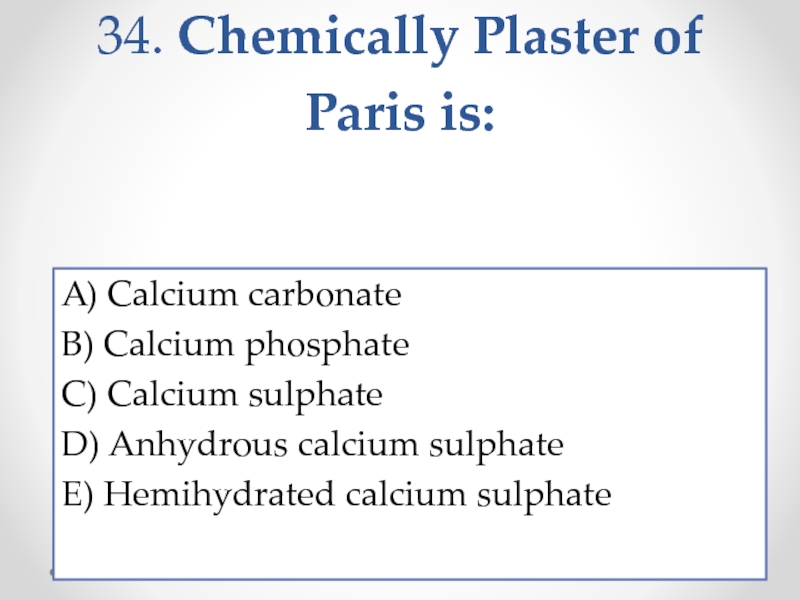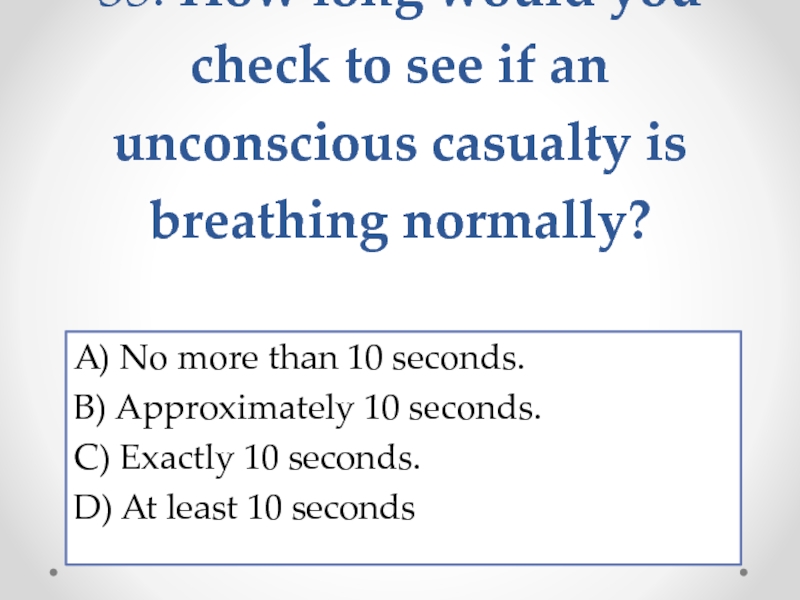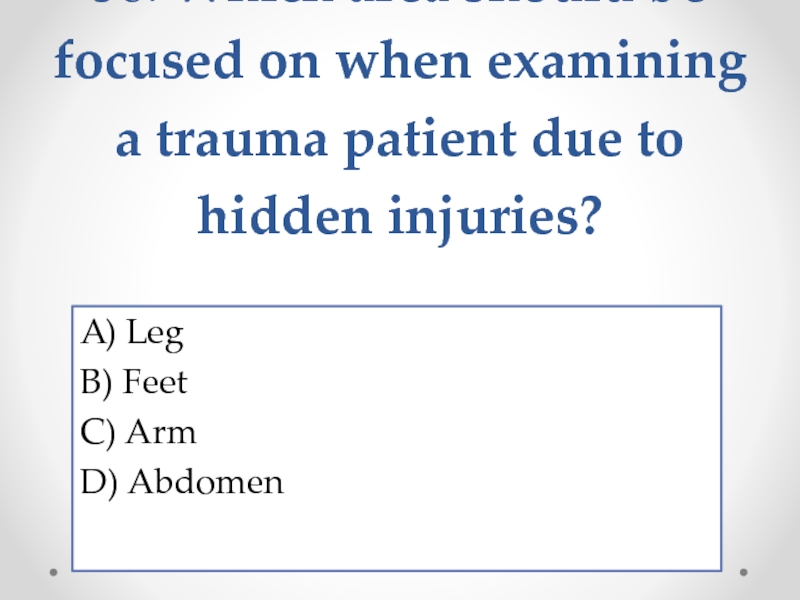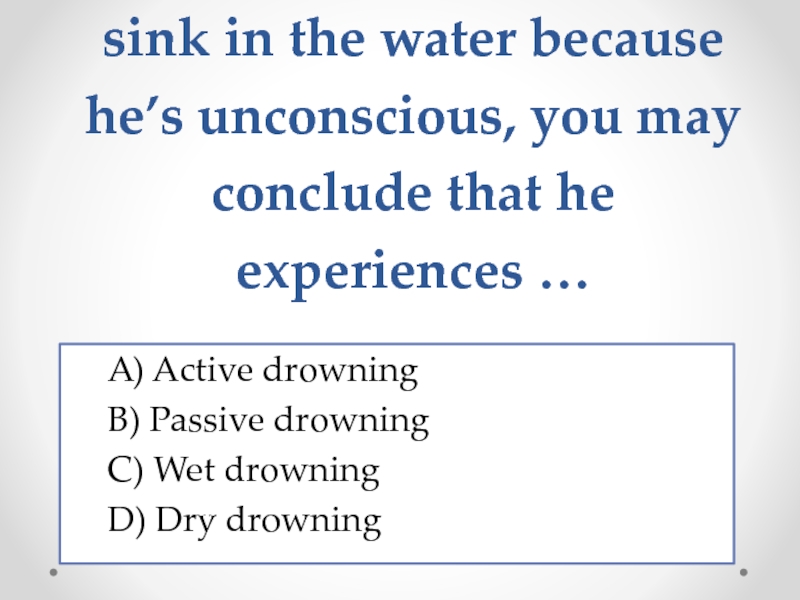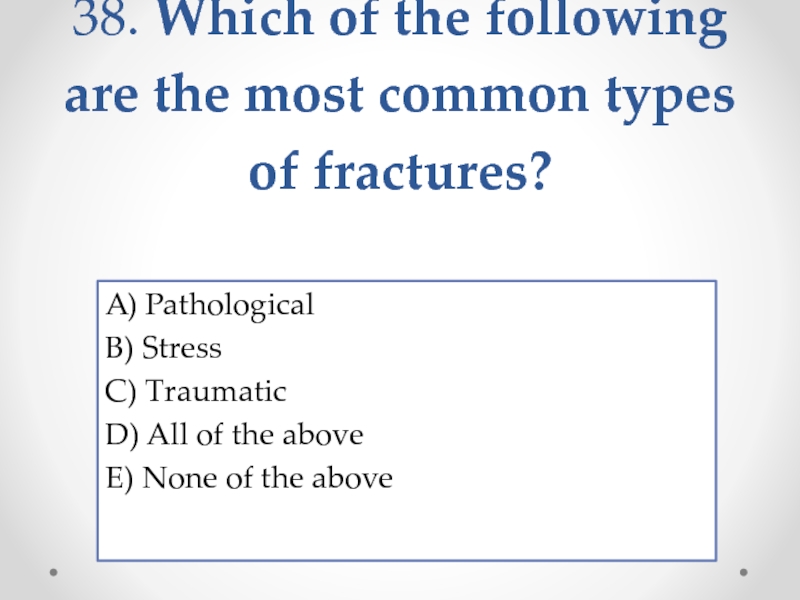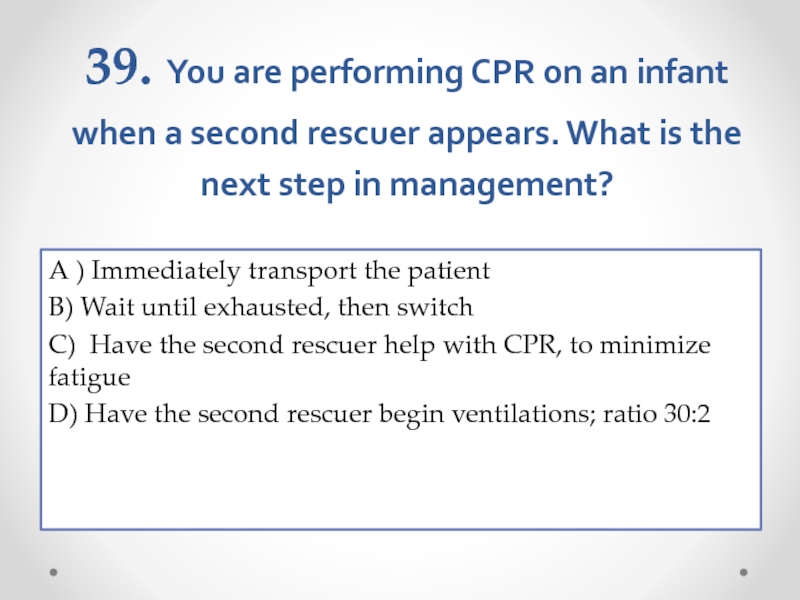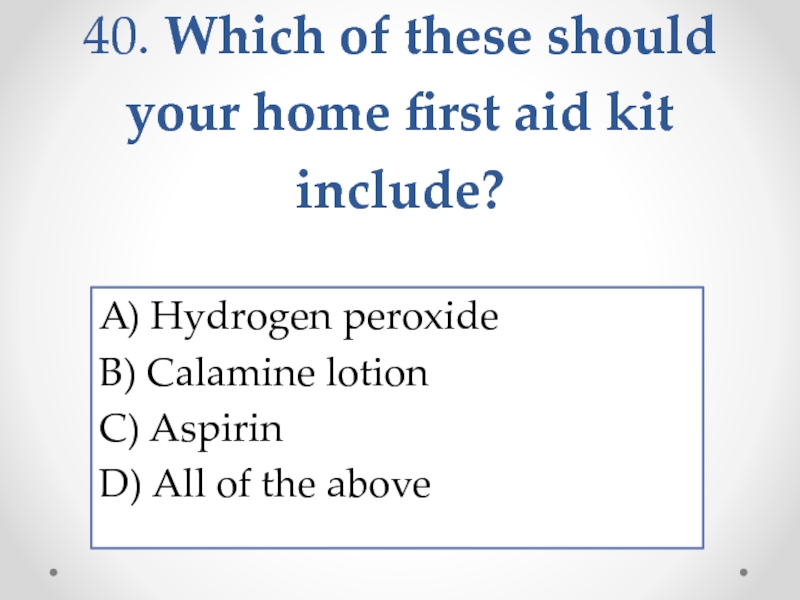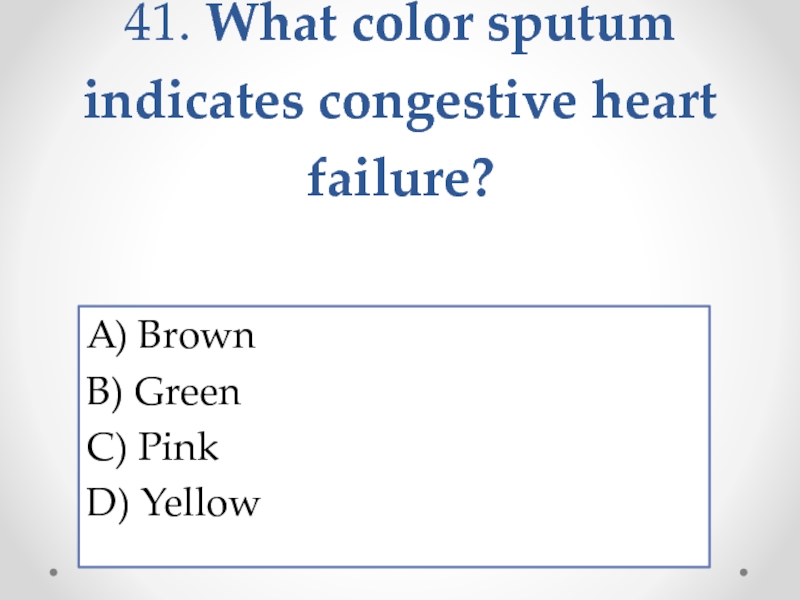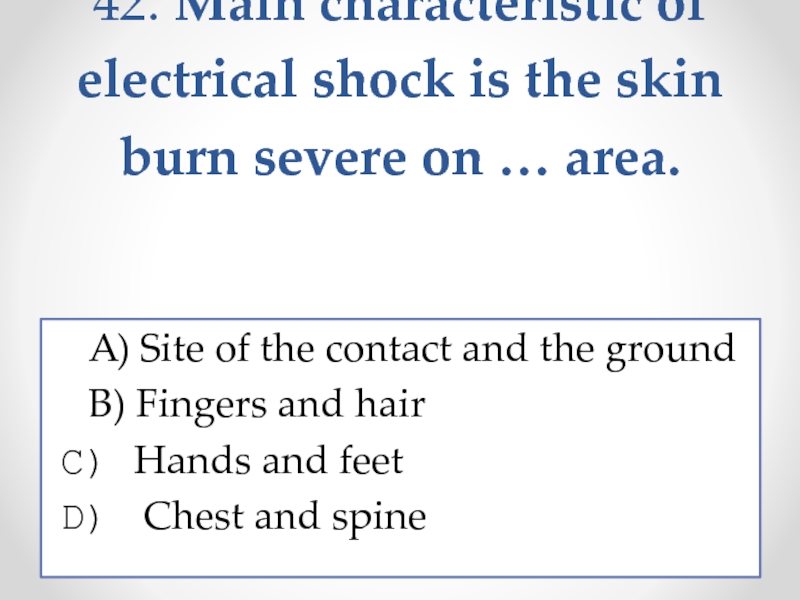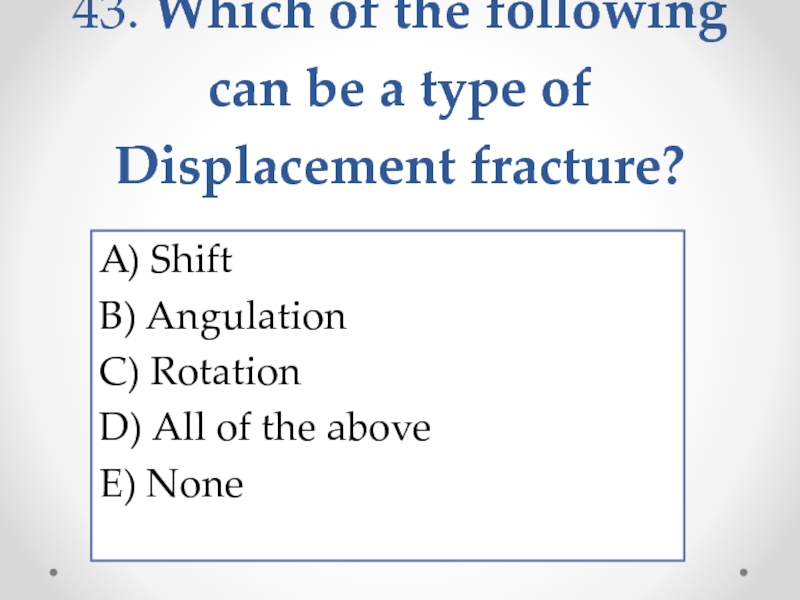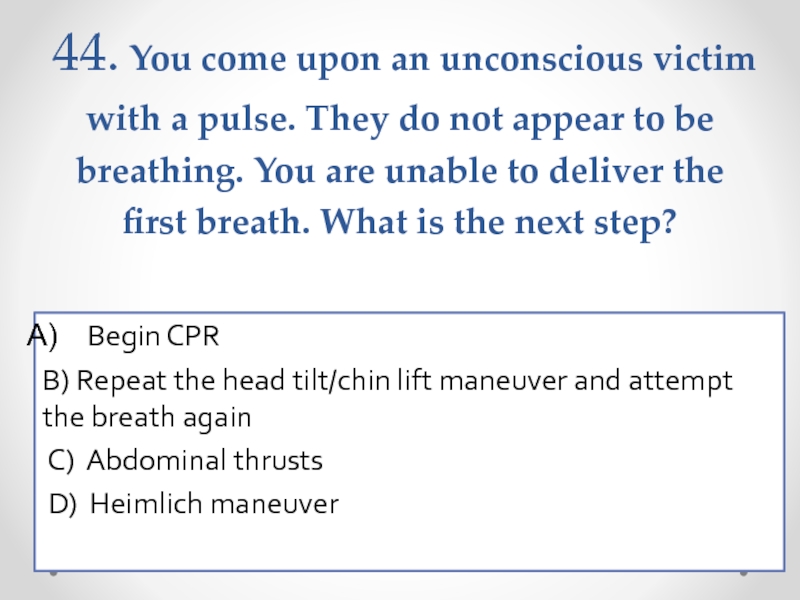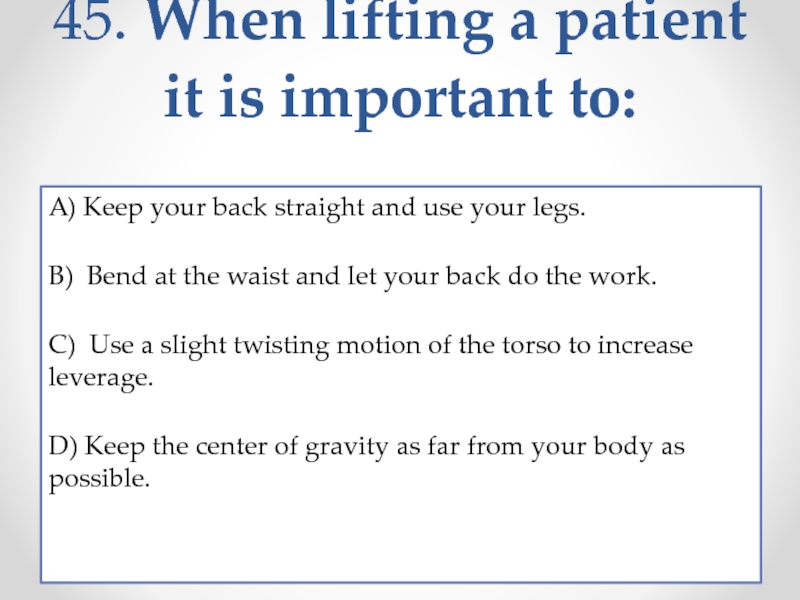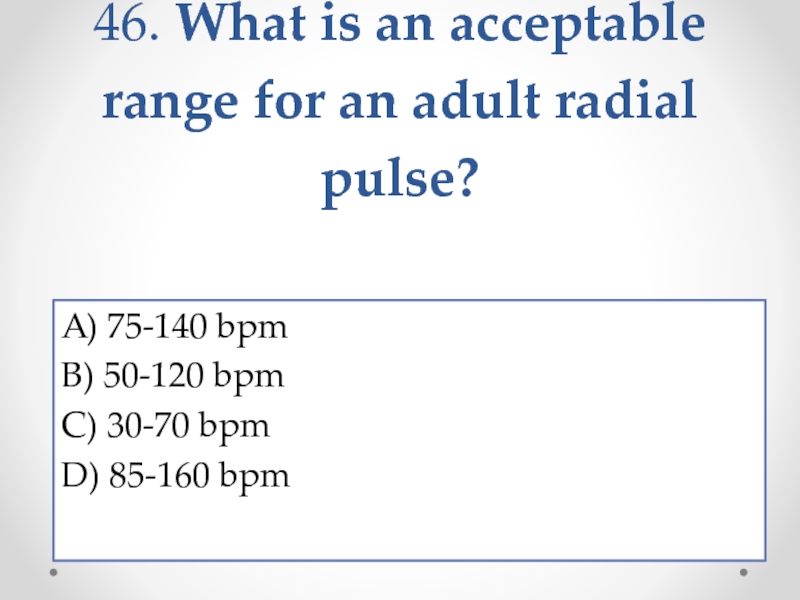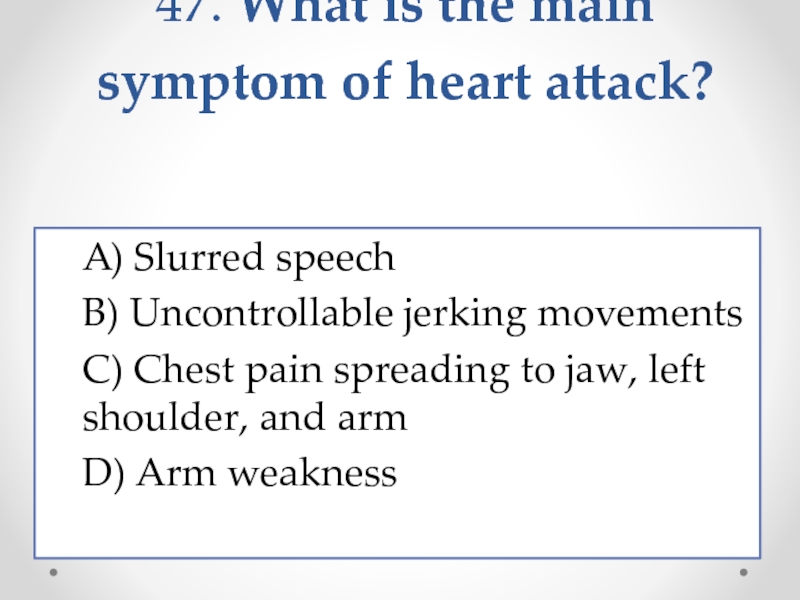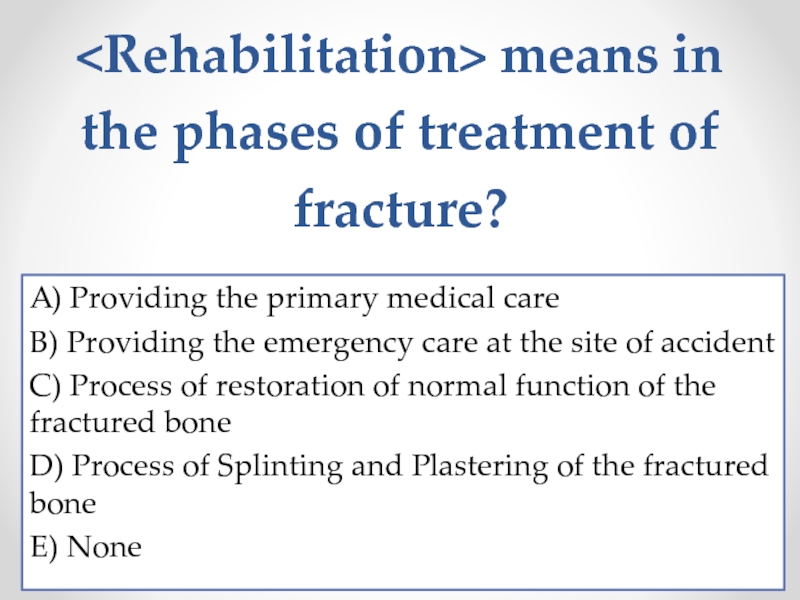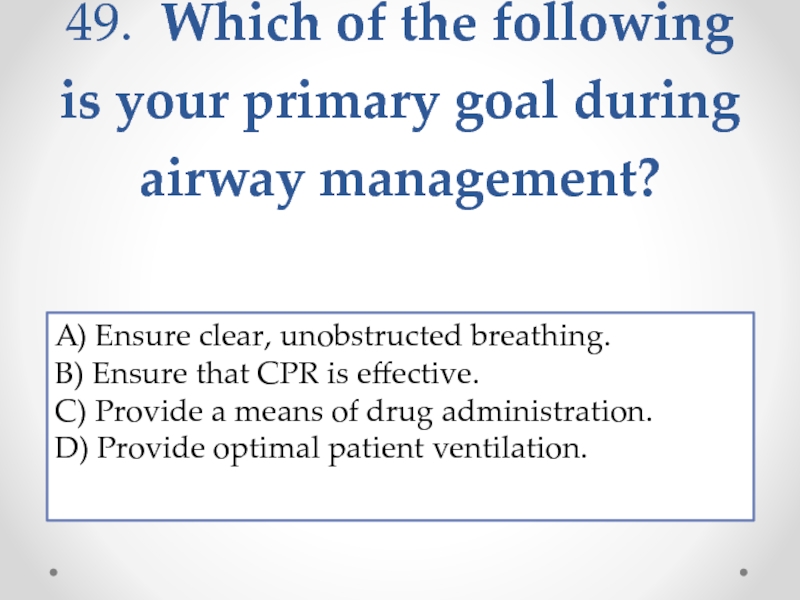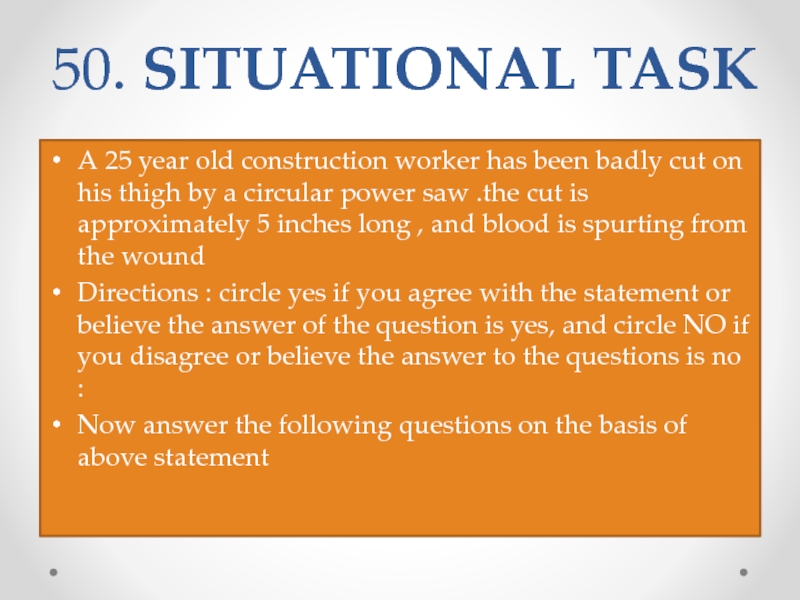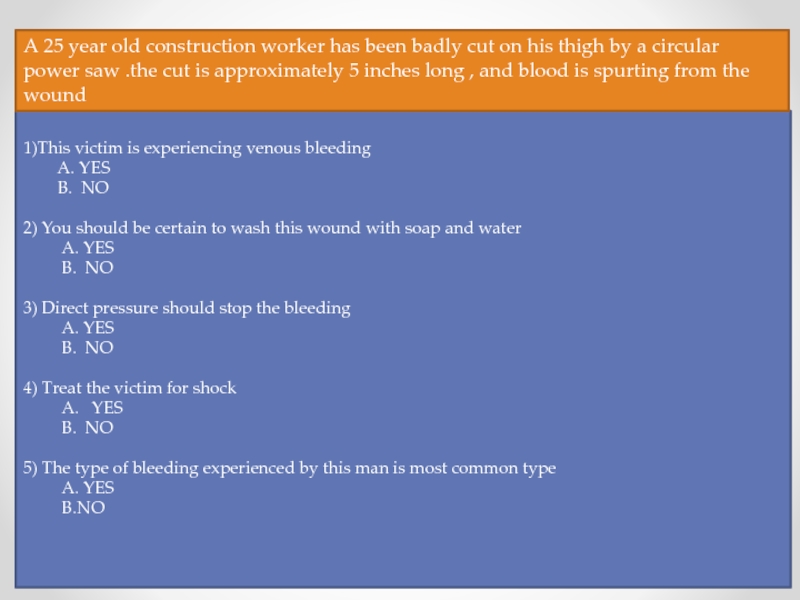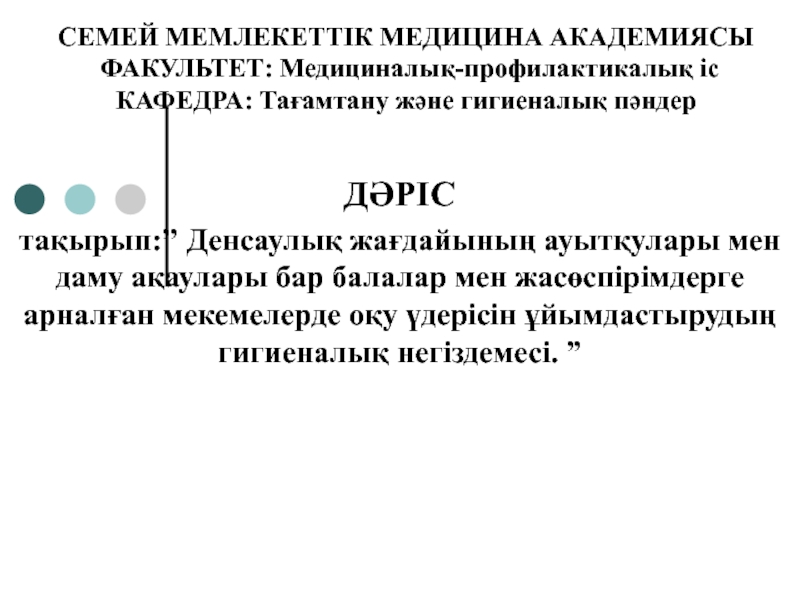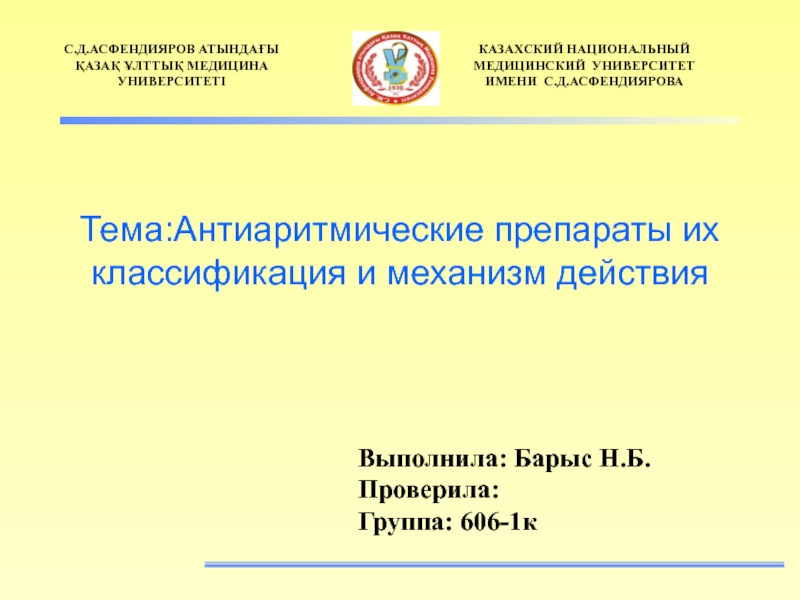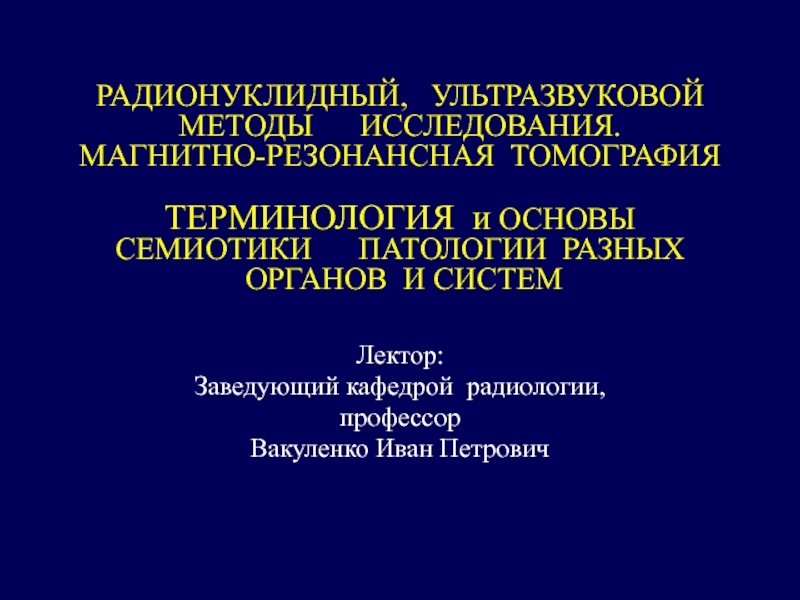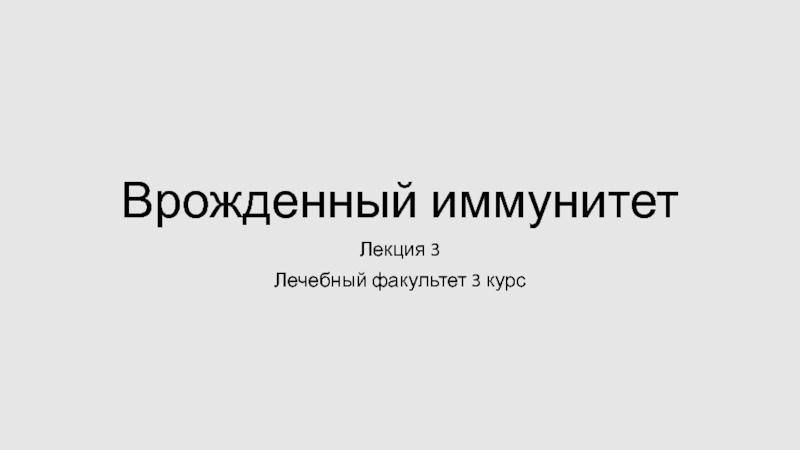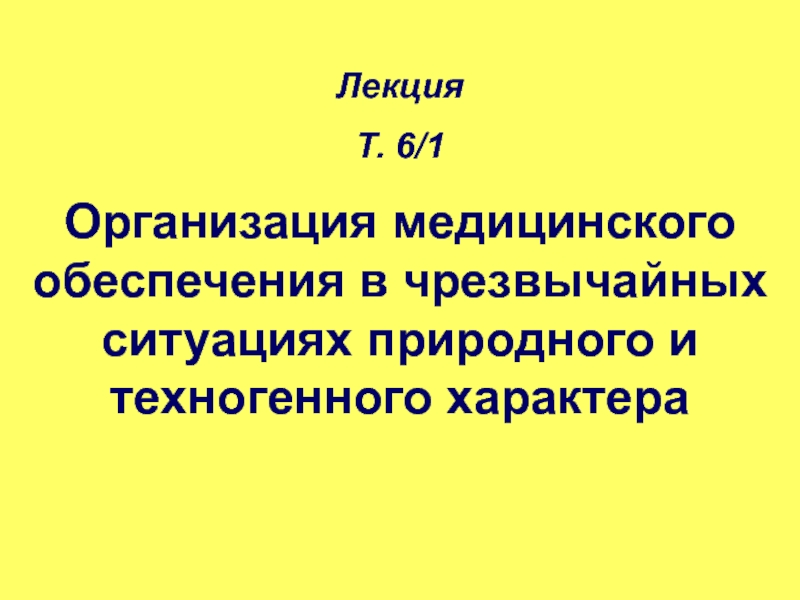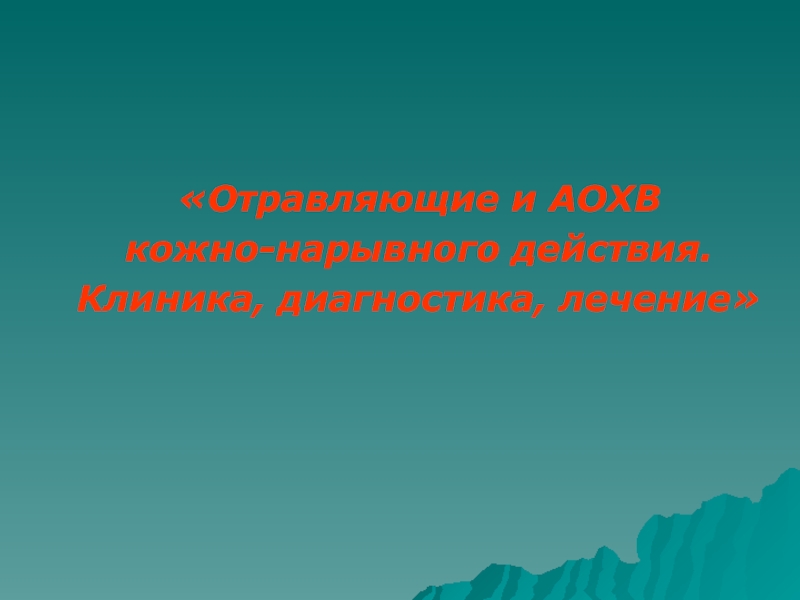A) Every 10-15 minutes.
B) Every 25-30 minutes.
C) Every 15-20 minutes.
D) Every 20-25 minutes.
- Главная
- Разное
- Дизайн
- Бизнес и предпринимательство
- Аналитика
- Образование
- Развлечения
- Красота и здоровье
- Финансы
- Государство
- Путешествия
- Спорт
- Недвижимость
- Армия
- Графика
- Культурология
- Еда и кулинария
- Лингвистика
- Английский язык
- Астрономия
- Алгебра
- Биология
- География
- Детские презентации
- Информатика
- История
- Литература
- Маркетинг
- Математика
- Медицина
- Менеджмент
- Музыка
- МХК
- Немецкий язык
- ОБЖ
- Обществознание
- Окружающий мир
- Педагогика
- Русский язык
- Технология
- Физика
- Философия
- Химия
- Шаблоны, картинки для презентаций
- Экология
- Экономика
- Юриспруденция
Emergency Patient Care Olimpiad-2018 презентация
Содержание
- 2. 1. How often should the minor injury
- 3. 2. What color is cerebral
- 4. 3. What is the main symptom
- 5. 4. Which of the following
- 6. 5. You are first on
- 7. 6. You arrive
- 8. 7. In cardiopulmonary resuscitation, after defibrillation is
- 9. 8.Which one of this medical emergency
- 10. 9. Which one of the following can
- 11. 10. Which of the following stages
- 12. 11. The laryngeal mask airway
- 13. 12. A targeted systematic survey performed in
- 14. 13. These are some medical
- 15. 14. Which of the following statements
- 16. 15. For stopping venous bleeding, we should
- 17. 16. What differences in a child’s
- 18. 17. Whenever possible which location should
- 19. 18. Our body stops shivering
- 20. 19. Most commonly fractured bone is:
- 21. 20. A TORNIQUET should be placed in
- 22. 21. A normal respiratory rate for
- 23. 22. Which is NOT considered one of
- 24. 23. When is the
- 25. 24. Purpose of splinting is/are? A) Reduce
- 26. 25. Arterial blood is characterized by. A)
- 27. 26. What is the first thing
- 28. 27. What is the first thing that
- 29. 28. These actions can be done to
- 30. 29. What is the second most
- 31. 30. Which of the
- 32. 31. Wheezing can be described
- 33. 32. How long does the initial assessment
- 34. 33. Fainting or dizziness as a result
- 35. 34. Chemically Plaster of Paris is:
- 36. 35. How long would you
- 37. 36. Which area should be focused
- 38. 37. When a victim suddenly
- 39. 38. Which of the following are the
- 40. 39. You are performing
- 41. 40. Which of these should your home
- 42. 41. What color sputum indicates congestive heart
- 43. 42. Main characteristic of electrical
- 44. 43. Which of the following can be
- 45. 44. You come
- 46. 45. When lifting a patient it is
- 47. 46. What is an acceptable range for
- 48. 47. What is the main symptom
- 49. 48. What does the term
- 50. 49. Which of the following is
- 51. 50. SITUATIONAL TASK A 25 year old
- 52. 1)This victim is experiencing venous
Слайд 21. How often should the minor injury patient be re-assessed after
Слайд 3 2. What color is cerebral spinal fluid when it leaks from
A) Yellow.
B) Brown.
C) Clear.
D) Red.
Слайд 4
3. What is the main symptom of stroke?
A) Blueness of
B) Uncontrollable jerking movements.
C) Breathlessness.
D) Arm weakness.
Слайд 5 4. Which of the following statement is not correct about the
A) High energy injury involving extensive soft- tissue damage.
B) Wound <1cm long.
C) Usually simple fracture with little comminution.
D) None of the above.
E) Both B and C are correct.
Слайд 6 5. You are first on scene and the victim is unresponsive,
A) Wipe off the face or cover with a shirt.
B) Compression only CPR.
C) Go and get help.
D) Do not initiate resuscitation.
Слайд 7 6. You arrive on scene to a car accident and are
placing a cervical collar and then doing a head tilt-chin lift.
B) doing the jaw thrust maneuver.
C) opening his mouth wide, while slightly hyperextending his neck.
D) doing the head tilt-chin lift.
Слайд 87. In cardiopulmonary resuscitation, after defibrillation is done, what is the
A) Check ECG for cardiac rhythm before more chest compression.
B) Continue uninterrupted CPR of 1 minute.
C) Continue uninterrupted CPR of 1-2 minutes.
D) Continue uninterrupted CPR of 2-3 minutes.
E) Continue uninterrupted CPR of 3-4 minutes
Слайд 9 8.Which one of this medical emergency relate to biological exposures of
A) Bone fracture after the earthquake.
B) Atopic asthma caused by pesticides.
C) Severe head trauma caused by falling bridge.
D) Flood related fungal skin rashes.
Слайд 109. Which one of the following can not be an example
A) Transverse.
B) Oblique.
C) Comminuted.
D) Closed.
E) Spiral.
Слайд 11 10. Which of the following stages of healing is represented by
A) Stage of hematoma.
B) Stage of Callus.
C) Stage of remodeling.
D) Stage of granulation tissue.
E) Stage of modeling.
Слайд 12 11. The laryngeal mask airway used for securing the airway of
A) In a difficult intubation
B) In cardiopulmonary resuscitation
C) In a child undergoing an elective/routine eye surgery
D) ln a patient with a large tumour in the oral cavity
Слайд 1312. A targeted systematic survey performed in a set order which
A) A = Airway assessment.
B) B = Breathing assessment.
C) C = Circulation assessment.
D) D = Danger assessment.
E) E = Exposure and environmental control.
Слайд 14 13. These are some medical emergencies relate to the environment, except…
A) Panic attack
B) Frostbite
C) Wet drowning
D) Heat stroke
Слайд 15 14. Which of the following statements regarding the management of open
A) Antibiotic-coated intramedullary nails have not been shown to impair osteoblastic activity.
B) High local concentrations of aminoglycosides have been shown to impair osteoblastic activity.
C) Intravenous antibiotic administration should be discontinued 48 hours following definitive wound closure.
D) Intravenous antibiotic administration should be commenced within 3 hours of injury.
E) In patients requiring treatment in a specialist trauma centre, the primary debridement procedure should normally be delayed until after transfer.
Слайд 1615. For stopping venous bleeding, we should apply pressure on.
A) Proximal
B) Distal side of wound
C) On the wound
Слайд 17 16. What differences in a child’s airway might make airway management
A)a smaller jaw and a proportionally larger tongue
B) There are no anatomic differences that affect airway management in children versus adults.
C) longer airway and small tongue
D) smaller jaw, smaller teeth
Слайд 18 17. Whenever possible which location should the patient be transported to
A) Farthest one
B) Least specialized
C) Closest one
D) Most specialized
Слайд 19 18. Our body stops shivering when the body core temperature is
A) 20-25 ˚C
B) 30-32 ˚C
C) 32-35 ˚C
D) 35-38 ˚C
Слайд 2120. A TORNIQUET should be placed in case of
A) Arterial bleeding
B)
C) Internal bleeding
D) Bleeding from carotid bleeding
Слайд 22 21. A normal respiratory rate for an adult is ____ while a normal
A) 12 to 20 and 16 to 24
B) 22 to 30 and 50
C) 8 to16 and 20 to 40
D) 12 to 20 and 30 to 60
Слайд 2322. Which is NOT considered one of the four T's of
A) Transport
B) Transfer
C) Treatment
D) Training
Слайд 24 23. When is the right time to do the passive rewarming
A) When the victim conscious and shivering
B) When the victim conscious but not shivering
C) When the victim unconscious and not shivering
D) When the victim has no vital signs
Слайд 2524. Purpose of splinting is/are?
A) Reduce pain
B) Reduce bleeding and swelling
C)
D) Prevent vascular constriction
E) All of the above.
Слайд 2625. Arterial blood is characterized by.
A) Dark red and spurting
B) Dark
C) Dark red and even flow
D) Bright red and spurting
Слайд 27 26. What is the first thing you should do before inserting a nasopharyngeal
A) Select the correct size.
B) Make sure the patient does not have a gag reflex.
C) Look up the nose to make sure the nostrils are large enough for a nasopharyngeal airway.
D) Tilt the head back, lube the airway, and insert it into the nostril
Слайд 2827. What is the first thing that needs to be done
A) Palpate the head
B) Examine the ears
C) Examine the nares
D) Inspect the eyes
Слайд 2928. These actions can be done to the frostbite victim, except
A) Drink warm liquids
B) Remove wet clothes
C) Rewarm the skin by rubbing
D) Immerse exposed area with warm water for 30 minutes
Слайд 30 29. What is the second most important aspect in the treatment
A) Adequate nutrition of patient
B) Accurate anatomical reduction
C) Immobilization
D) Restoration of bone alignment
E) Antibiotics.
Слайд 31 30. Which of the following is the correct sequence for the
A) 911/112. CPR. Defibrillation. Advanced care.
B) CPR. Defibrillation. 911/112. Advanced care.
C) Defibrillation. CPR. 911/112. Advanced care.
D) Defibrillation. 911/112. CPR. Advanced care.
Слайд 32
31. Wheezing can be described as ____.
A) a high-pitched whistling sound
B) wet,
C) loud snoring sound
D) tiny popping sound
Слайд 3332. How long does the initial assessment generally take?
A) 2 minutes
B)
C) 14 minutes
D) 10 minutes
Слайд 3433. Fainting or dizziness as a result of overheating is the
A) Heat cramps
B) Heat stroke
C) Heat tetany
D)Heat syncope
Слайд 3534. Chemically Plaster of Paris is:
A) Calcium carbonate
B) Calcium phosphate
C) Calcium
D) Anhydrous calcium sulphate
E) Hemihydrated calcium sulphate
Слайд 36 35. How long would you check to see if an unconscious
A) No more than 10 seconds.
B) Approximately 10 seconds.
C) Exactly 10 seconds.
D) At least 10 seconds
Слайд 37 36. Which area should be focused on when examining a trauma
A) Leg
B) Feet
C) Arm
D) Abdomen
Слайд 38 37. When a victim suddenly sink in the water because he’s
A) Active drowning
B) Passive drowning
C) Wet drowning
D) Dry drowning
Слайд 3938. Which of the following are the most common types of
A) Pathological
B) Stress
C) Traumatic
D) All of the above
E) None of the above
Слайд 40 39. You are performing CPR on an infant when a second
A ) Immediately transport the patient
B) Wait until exhausted, then switch
C) Have the second rescuer help with CPR, to minimize fatigue
D) Have the second rescuer begin ventilations; ratio 30:2
Слайд 4140. Which of these should your home first aid kit include?
A) Hydrogen
B) Calamine lotion
C) Aspirin
D) All of the above
Слайд 43 42. Main characteristic of electrical shock is the skin burn severe
A) Site of the contact and the ground
B) Fingers and hair
Hands and feet
Chest and spine
Слайд 4443. Which of the following can be a type of Displacement
A) Shift
B) Angulation
C) Rotation
D) All of the above
E) None
Слайд 45 44. You come upon an unconscious victim with a pulse. They
Begin CPR
B) Repeat the head tilt/chin lift maneuver and attempt the breath again
C) Abdominal thrusts
D) Heimlich maneuver
Слайд 4645. When lifting a patient it is important to:
A) Keep your
B) Bend at the waist and let your back do the work.
C) Use a slight twisting motion of the torso to increase leverage.
D) Keep the center of gravity as far from your body as possible.
Слайд 4746. What is an acceptable range for an adult radial pulse?
A)
B) 50-120 bpm
C) 30-70 bpm
D) 85-160 bpm
Слайд 48
47. What is the main symptom of heart attack?
A) Slurred
B) Uncontrollable jerking movements
C) Chest pain spreading to jaw, left shoulder, and arm
D) Arm weakness
Слайд 49 48. What does the term means in the phases of
A) Providing the primary medical care
B) Providing the emergency care at the site of accident
C) Process of restoration of normal function of the fractured bone
D) Process of Splinting and Plastering of the fractured bone
E) None
Слайд 50 49. Which of the following is your primary goal during airway
A) Ensure clear, unobstructed breathing.
B) Ensure that CPR is effective.
C) Provide a means of drug administration.
D) Provide optimal patient ventilation.
Слайд 5150. SITUATIONAL TASK
A 25 year old construction worker has been badly
Directions : circle yes if you agree with the statement or believe the answer of the question is yes, and circle NO if you disagree or believe the answer to the questions is no :
Now answer the following questions on the basis of above statement
Слайд 52
1)This victim is experiencing venous bleeding
A. YES
2) You should be certain to wash this wound with soap and water
A. YES
B. NO
3) Direct pressure should stop the bleeding
A. YES
B. NO
4) Treat the victim for shock
A. YES
B. NO
5) The type of bleeding experienced by this man is most common type
A. YES
B.NO
A 25 year old construction worker has been badly cut on his thigh by a circular power saw .the cut is approximately 5 inches long , and blood is spurting from the wound
